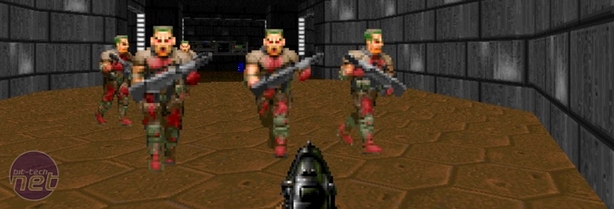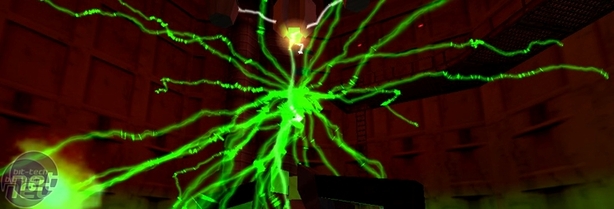
The Greatest Game Story Ever Told
The father of modern gaming is, I hope we can all agree, Doom. Yes, we can trace things back further than Doom, all the way back to Cathode Ray Tube Amusement Device if we want, but things really got exciting when Doom showed up.There’d been games before Doom, games with complex stories such as Zork or CCC, but Doom was the game that hooked most of us and, most importantly for our purposes, it was the one which changed the way most people thought about games.
It took us from the age when games were monochrome, squinty affairs played by people with milkbottles for spectacles, to a time when it was actually cool to spend ages hooking up a modem connection between two PCs. Doom made an immeasurable impact on the industry. It established exactly what a deathmatch should be, it brought competitive gaming to the mass media, harnessed the power of the community through mods and invented speedruns and telefrags.
Doom's legacy is still being felt today in fact and it's a fair bet that you can take any shooter off a shelf, from America’s Army to Zeno Clash, examine it, and list a dozen things that those games owe to Doom. Things like the wobble of the guns and the on-screen feedback that tells you which direction you are being shot from - these were things that id Software invented.
On the other hand, from a story perspective, Doom was absolutely rubbish. You start in a room, no idea what’s going on and you are surrounded by demons. You have to read the manual and supporting media to get a grip on it all – something modern games would get heavily slated for doing. Yet the idea that plot was optional caught on and the same flaw was replicated in other games of the era, such as Quake and (to a lesser extent) Duke Nukem 3D. There were years and years where the lessons of early story-driven games were forgotten and all anyone really cared about was having as many sprites or polygons as possible.
Duke Nukem 3D is a notable turning point from a stylistic point of view, introducing the idea of a vocal player character with a pre-defined personality in an FPS – but it’s one which has also been outdated since then. Like Doom, Half-Life changed the way we think about games in general – though it did it not by focusing on action and abandoning story, but by melding the two together so fluidly. When Half-Life landed in 1998, it was so successful (and the games industry was industrious enough by that point) that it again changed the face of gaming overnight – this time in the opposite direction. Half-Life made so much money people are still trying to copy it.
Between Doom and Half-Life there had been two main types of games. There were the ones that didn’t have stories, like Quake, and there were the ones which had often over-ambitious cutscenes to create a plot. Some of the cutscenes were done with in-game tech, but most often they were still-based or FMVs, ala Realms of the Haunting or Jedi Knight. They were... OK, at best and scandalously bad[ at worst.
What Half-Life did was introduce a third option; telling a story without cutscenes and without breaking from the FPS perspective, a method later used by the likes of BioShock and Call of Duty 4 to make you feel like a proper part of the story and not just a puppet-master for Duke Nukem or his kin.
Generally speaking, it’s still the way we prefer our first-person shooters to tell their stories; Valve was the first developer to really understand how making an experience truly immersive can compensate for what’s really a somewhat rambling and incoherent storyline.

MSI MPG Velox 100R Chassis Review
October 14 2021 | 15:04











Want to comment? Please log in.